Acceleration Flow Part 2
Read part one of this essay.

Designer Strategies for Acceleration Flow
The Covert Level-Up System
One important application of this article that might not be immediately obvious is the ability to recognize level-up systems and acceleration flow when they are disguised. In any instance where a player is experiencing flow-like exhilaration, and yet is essentially doing the same increasingly simple task over and over again, it is probably a case of acceleration flow. Even if there is no blatant level-up system at work, looking deeper will reveal the techniques underpinning the gameplay.
For example, I believe Katamari Damacy has one of the most ingenious level-up systems in all of videogames. It also includes an excellent example of acceleration flow induction, in a clever way. As the Katamari absorbs more objects, it can take on increasingly large objects and tasks. Or, to put it another way, for every task it completes the player character gets stronger and more able to take on new tasks. That’s leveling up; no doubt about it. The genius of the game is that its MLPR is tied in to real-world objects. At first the player character spends most of the time picking up small objects, gradually increasing from paperclips to pencils, to dogs, to humans, to houses, and so on.
There is a short MLPR built into most of the levels, involving the time limit and the sizes of the objects the player picks up. Nobody has to tell the player the difference in size between dogs and paperclips; that’s an obvious real-world datum. So when the player is able to go from picking up paperclips to picking up city blocks and weather systems, the sense of acceleration is great. The developer never has to tell the players that they’re leveling up; they enjoy it anyway.
Acceleration throughout a Game
Acceleration can happen anytime. Moreover, no game adheres perfectly to any aspect of acceleration flow or all level-up systems would be more or less the same. Although acceleration is theoretically most easily accomplished at the end of a game, in practice, it is used all over, all the time. Take, for example, a very common JRPG structure.
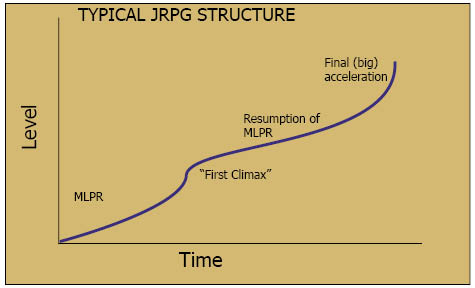
This is frequent in Final Fantasy or Zelda games; it happens in Shadow Hearts, Star Ocean 2, Dragon Quest, Wild Arms, etc. This is the “first climax” of a game that introduces a player to the more difficult second half, and also usually engages the pursuit of the main villain or object of the game.
Interconnected Level Systems
One way developers build in periodic accelerations is to employ several different things (crafting, factions, character level) that level up in the same game. It’s important to remember that anything that translates into a permanent increase in player character power is part of the level-up process. In a game with a level-up system, everything that a player accumulates translates into increased power:
- Each new piece of gear augments character stats much like levels would
- Ability points are just experience for player skills
- Currencies like gold, gil, bottlecaps or what have you can be invested into weaponry or crafting pieces, new abilities, and the like
- Faction points are just an experience bar appended to a gear merchant or ability trainer
- Crafting skills just increase the speed of gear acquisition through alternative level progression
A level-up system with several different areas of progression can serve two purposes. Most obviously they can make a game longer; this can sometimes result in tedium as players have to grind out each level-up stream one by one. If done well, however, a set of interconnected levels can actually be a tool for achieving periodic accelerations. It looks something like this:
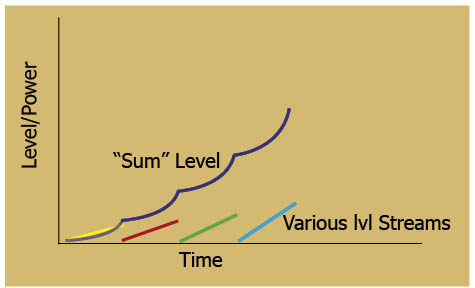
Each system that can be leveled contributes to an overall or “sum” level. Effectively, this just increases the frequency of the increments at which a player character grows more powerful, even if those increments are smaller. There’s also an inherent acceleration built into an interconnected system. As each portion of the system goes up in level, the un-leveled remainder of the system becomes easier. That’s an R/C and R/T change with all of the natural results.
The interconnected system of level-ups is a localized acceleration; the player might not advance beyond the MLPR of the sum-level, but they still feel an acceleration occurring, which can keep players happy and motivated. The R/C and R/T manipulations give the player a sense that they can make a difference in the game with clever thinking and planning.
Gating and MMO Acceleration Techniques
Naturally, there are many instances when developers need to make acceleration possible and yet tightly control or restrict its overuse. I hate to beat a dead horse, but WoW is a great example for the MMO models. It has either influenced or appropriated just about every level-up technique that exists. I don't regard that as equalling the height of sophistication, but it would be wrong for me to not give the game its due in full. The way that the level-up system has become wound around the business model is fascinating from the position of an ex-player. It goes something like this:
- Player reaches maximum level, but is wholly underequipped for the central piece of endgame content, the raid.
- Player goes through a number of dungeons specifically tuned to underequipped max-level players.
- The gear from these max-level dungeons accrues relatively quickly and is both powerful and fairly diverse. That is to say, no equipment slot will be left empty.
- The player experiences their first max-level acceleration during this dungeon run as each piece of gear makes them more powerful and more able to get the next piece of gear, in short order. (This was slowed a bit in Cataclysm.)
- Player enters raiding content to start the process all over again, with each successive raid acting as the new baseline for the next raid.
The first set of max-level equipment is extremely powerful and easy to get relative to the MLPR of the game. That MLPR has been enforced by the many levels it took to get to max (85 currently), as well as the levels of the discrete sections (expansions, patches) that were released in sequence. It's much easier to see the difference, however.
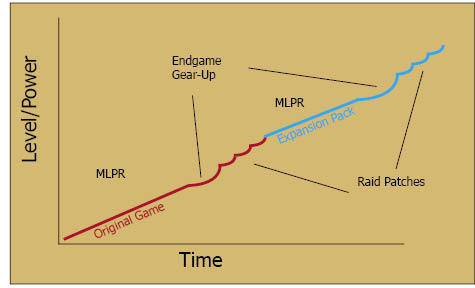
As you can see, with every new expansion, and even with every new patch within an expansion, an acceleration curve is established. Of course, if the pace is changing so often, how can there be an MLPR to deviate from? The biggest MLPR is determined by the expansion; how long it takes to get to the new level cap is the MLPR. The MLPR relevant to raiding is generated by the consistent pacing of most raids. It takes roughly the same amount of time to accelerate, regardless of the raid. Some raids have a higher peak acceleration, but most follow the same approximate deriviative of deviation from the MLPR.
It’s important to note that although acceleration is the cornerstone of MMO endgame, WoW doesn’t let players simply have at it, freely. Instead, WoW and other MMOs put an absolute limit on the amount of acceleration that can be done in a given period of time. This practice I call gating: the designers put an absolute limit on the level-up process. Usually this “gate” is related to the passage of real time. World of Warcraft does this in weekly raid lockouts. Although there are no doubt some raiding teams that would like to complete the latest 10+ person dungeon (or portions of it) several times a week, it is only possible once. Moreover, in late Wrath of the Lich King patches, Blizzard further subdivided raids into sections that came out weekly or bi-weekly. All of this is simply a way of preventing a full acceleration. By giving the players only a taste of the acceleration, the game keeps them coming back until the next patch or expansion is released. Most MMORPGs do this in one way or another.
Zynga, however, reigns supreme in the world of gating. All of Zynga's titles employ gating extensively, with the purpose of fueling microtransactions. In a Zynga game, every action the player can take is gated by some kind of mechanism that works in real time. In the -ville games, for example, crops and buildings "grow" in real time over a matter of hours. There is also an "energy" bar that puts a limit on the number of actions a player can take. This energy bar levels up, as do the different types of crops/buildings that a player can use. All of this is to give the player the impression that they will be able to achieve a more favorable R/T, but it isn’t so.
It is, in fact, nearly impossible to accelerate without paying a microtransaction. If anything, the rate at which the player character levels up goes down as the character level climbs, especially after the introductory period is over. Or, in graphical terms:
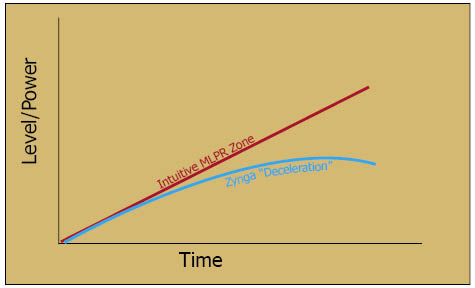
You can see where the player wants to be, in terms of consistent leveling. The game is designed to steer them away from their desire, so as to encourgage the purchase of extra energy or time-saving perks. Or, in other words, there is no way to change the R/T ratio into the player's favor except by paying real money.
Spiking
For all the talk of World of Warcraft that inevitably had to happen in a discussion of this subject, it’s not the most interesting Blizzard level-up system there is. Diablo definitely holds that title for its cleverness and extremity of acceleration. As the developers said in the Diablo 3 trailer: "There's no such thing as too much power." And, generally, they meant it. There are two design features that are most characteristic of Diablo 2's level-up system. The first feature is unlockable benchmark abilities. I mentioned this before; every few levels new abilities become available. Generally, each tier of unlocked ability is significantly more powerful than the last. It's a recipe for periodic accelerations as the power of each new ability accelerates the ability to level up. To illustrate:
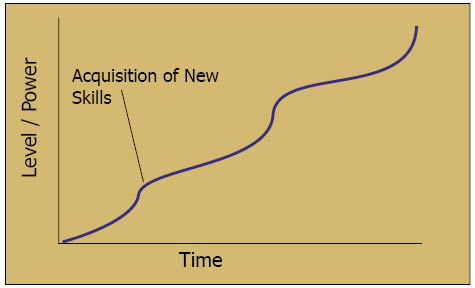
As you can see, at level thirty the final and most powerful level of ability is unlocked. The accelerations become longer and less frequent after this.
The second feature that makes Diablo 2 so special is a random loot table with a large range. Random loot tables are hardly unique, but Blizzard's execution is what makes them special. Contained within the loot table are very rare random items, powerful enough that just one of them can dramatically alter the power of the player character. This is exciting because acquiring one of these items, randomly, can result in a sudden acceleration. The player character gets a new item and becomes more powerful; the experience they receive from monsters is still the same as it was before the item. It's a simple R/C change, where the C goes down and the R stays the same.
For Diablo 2, these items are random and can drop anytime. Thus accelerations could always be just one random item away; and this can be very exciting for players. Additionally, each major section ("act") of the game comes with an end-boss, most of whom will be more likely to drop precious items than a common enemy. Usually this means that at the end of each act, the player character is likely to get an item (still randomly selected) that will power them up considerably. The end of each act corresponds roughly to the level at whch a new, more powerful ability becomes available. Thus, there is a great amount of consonance between new abilities and the incidence of rare items, heigtening the ability-based accelerations.
The game needs to remain interesting, however, and so Blizzard employs a strategy I call spiking. You can see this happening on the graph below:
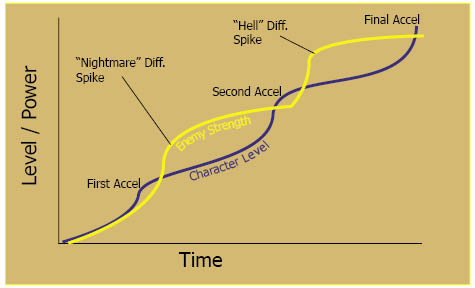
After the jump in power, the turnover into nightmare difficulty begins a sharp increase. What has happened here is that Blizzard designed in accelerations, and then responded to their own design with a huge spike in enemy strength. The important difference from an MMO design (obviously, it predates most of them) is that instead of each section or patch being equally difficult, every section is more difficult than the last. The R/C is still roughly the same, however, as the rewards have gone up commensurately.
The criteria for a spike differentiate it from a mere change in difficulty (which is employed in the other kind of flow.) The criteria for a spike:
- A noticeable acceleration must have occurred in the recent past
- The difficulty must grow significantly beyond anything that came before
- Although the challenge grows, the R/C must not become severely distorted so as to modify the MLPR. If it does, that's actually gating via unconventional means. (The “beef gate”.)
Because of this, each acceleration feels different, although they’re really all the same if you look at the whole game. In Diablo's “normal” and early “nightmare” difficulties, slaughtering hundreds of enemies in a few minutes is nothing, post-acceleration. On “hell” difficulty, a dozen enemies pose the same level of threat as that earlier army. And yet, because they offer such increased rewards, the player feels more accomplished for defeating so few. R/C can, perhaps, seem different in such a case, but the R/T ratio will remain firmly intact and keep the player striving toward that next acceleration.
Targeted Acceleration
Final Fantasy 7 is another great example of designers inducing a massive acceleration with new abilities and gear. The player gains a lot of firepower very quickly. This includes but isn't limited to each character's ultimate weapon (most are easy to get), the "Ultima" spell, the "Knights of the Round" summon, the "Contain" spells, and higher limit breaks. It's a lot of firepower dumped on the player in just a few hours of gameplay. Moreover, by that time most of the earlier abilities have matured into their highest level: Fire 3, Cure 3, etc.
Final Fantasy 7, like many games, uses the technique of a targeted acceleration. Naturally, there are no extra difficulties or content patches for old-school console games. In fact, wthout deviating much from the MLPR, or aquiring all of these items and abilities, it is possible to beat the main antagonist (and thus the game) of Final Fantasy 7 in relatively short order. In order to sustain an acceleration, the designers built into the game the optional bosses Ruby and Emerald Weapon. Wisely, neither of these extra challenges are located at the end of a tedious dungeon or other time-sink. The player can actually size up the difficulty of the bosses by jumping into the battle quickly, seeing how hard his or her ass gets kicked, and then return to the acceleration with a goal in mind. The optional bosses provide a target for acceleration. The player deduces the kind of power it would take to defeat them, and gets a hint of the promise that lies beyond the prediction horizon.
The Disgaea series uses both targeted acceleration and spiking techniques, although it uses them much more frequently and in a unique way. Disgaea is a series built around the notion of acceleration flow; I can think of no other series in which accelerations happen so often or so dramatically. Disgaea does everything uniquely, however:
(1) It uses the principle of interconnected level systems to the maximum. Characters, classes, skills, armor, weapons, merchants, and even outside-of-battle perks all level up. With such a high incidence of interconnection, it's tremendously likely that players will find a way to accelerate often, and a way to accelerate beyond the “local” interconnection.
(2) Spiking happens, but instances of spiking are usually left in the hands of the player. The player can control multipliers that enhance or diminish the level of the enemies faced in several arenas. There are many stages specifically set up to be areas where a sharp spike will precede a huge R/C & R/T turnaround (in the player’s favor). Effectively, these stages are power-levelling spots taken to the extreme.
(3) Optional bosses are numerous, accessible, and graded. That is to say, there are many optional bosses, they're easily accessed from a mission hub, and each one is progressively a lot harder than the previous one. Each boss represents a new target for a new and even bigger acceleration.
There are, of course, many other games that use spiking and targeted accelerations. Nothing I have described here is a secret; designers are well aware of this and often use it, especially in the age of metrics.
Level Shaping: Maintaining an Absolute Value for R/C
There are game-wide ways to prevent or control accelerations. I call these strategies "shaping" strategies, as they passively provide a mold which the player character(s) can fill, but not break out of. An example might be level-scaling, in which enemies, quests, and rewards are all scaled to match the current level of the player character. If the PC is level 10, everything else will be level 8-12. If the PC is 45, everything else will be level 42-48, etc. This effectively prevents an imbalance in the R/C ratio, because the intended challenge will always be roughly appropriate for the player. It is certainly still possible for the player to manipulate the R/T ratio with liquidating or some other tactical choice, but the chances for an acceleration are definitely fewer.
Final Fantasy 8 and The Elder Scrolls: Oblivion use shaping to different effects. In Final Fantasy 8 the static R/C ratio is used to force the players to invest in the tactical "junction" system. Acceleration is definitely a possibility, it's just not possible without first playing the game as the designers intended. In Oblivion, meanwhile, level shaping is a disaster. Random monsters, which are encountered frequently, will have their levels scale closely with the player character; sometimes above the player character. What's more, the rewards never really go up. There have been a number of well-known mods that corrected for Oblivion's ridiculous scaling monsters, many of which are deemed essential for enjoying the game. Bethesda intended for the game to remain at roughly the same R/C ratio throughout, but it didn’t quite work out that way.
Experimental Design and Concerns
I am not a professional researcher or psychologist; I do not have the resources to test this hypothesis in dozens of different games with hundreds of subjects. I do, however, have a few suggestions for experimental design based on the principles about which I hypothesize in this paper.
Firstly, anyone trying to perform an experiment on the phenomena surrounding the idea of acceleration flow needs an independent and dependent vairable. This, I expect, will always be difficult, because any experiment ought to involve real games made for entertainment purposes, and not invented games made for psychological purposes. Real games will always be imperfect for research purposes for a variety of reasons. For one, all games have different creators. For another, most games are trying very hard to be unique, and therefore will deviate from any perceived "standard."
Usually, however, the principle independent variable is the change in (derivative of) deviation from the MLPR. The resultant dependant variable is the subjective report by players of excitement at different points in the derivative's growth. They rate the strength of the excitement, and this rating tells a designer to what degree an acceleration is working.
Players will always present a problem in testability because in any decent game (and the good ones are certainly worth study) the player is not totally bound to any one behavior. Players can fail, and depending on the player's motivations they may confound a study in any number of ways. There are a few guidelines that immediately spring to mind for charting player level-up progress:
(1) If they know that they are being monitored for a study on leveling-up, players will try to optimize their performance as such. Don't tell them that; just tell them they're being monitored. Obviously this isn't a problem in an MMO where metrics can be pulled out of the servers easily; MMOs are great in this regard. Not everything is an MMO, however, and not everything should become like one.
(2) Do not ask players to chart their own progress during play. Charting progress will cause all the problems for players listed in item #1, even if you instruct them to chart dubious metrics to distract them from your true purpose.
(3) Use exclusively first-time players unless your study is specifically about experienced players performing accelerations at times the designer didn't intend. First time players are the most likely to be putty in the hands of the design, so to speak.
(4) If you are charting something for which automatic metrics are not possible (older console RPGs and such) you may want to create some kind of program which automatically detects the sound or graphic associated with a level-up in your recording. Even at 10x speed, it would take a research assistant as many as 6 hours per playthrough to get the data on those longer games.
(5) It will be difficult to get timely reports of excitement from players in non-supervised settings. Supervision is a possibility where the resources to do so are available. Physiological metrics, where possible, are also a reasonable choice.
Charting during play is very tricky, but having the players report their excitement / satisfaction level after play is unavoidable. Therefore, players can report that level after each play session. The data can be matched to recorded deviations from the MLPR.
Finding the correlation between the (1) derivative in the deviation from the MLPR and (2) average subjective euphoria score will tell the developer quite a bit. Effectively it tells the player how much acceleration equals how much excitement in the player. We'll call this the Deviation / Euphoria Relationship (DER). It will obviously differ quite a bit from game to game. MMO developers should be particualrly interested in this relationship.
During the endgame of an MMO, it is important that a developer continue releasing content that will keep players engaged. Usually this means performing periodic, slow accelerations, like releasing endgame raid/gear sets. It is important to first ascertain the target peak deviation from the MLPR. Often, this target will be a range. Designers can then use the DER and target peak to project how long they can make their game at whichever level of excitement they choose. Usually, however, they are obligated to:
-Stay below or completely obviate perk thresholds that would cause imbalances -Not devalue pre-acceleration stats so as to create a pre-acceleration ghetto. -Not totally blow away extra-accelerational tasks (like side quests, dailies, achievements, etc) with game-breaking powerThere is, naturally, an average minimum euphoria score that it takes to keep players leveling. To find that score out, just take a survey; it has little to do with this paper. The DER, however, will tell the developers how much acceleration needs to happen to maintain that minimum euphoria score in future projects of strong similarity. Therefore, the DER, if it can be ascertained, is incredibly useful for drawing out the length of endgame content--in a sense, keeping the excitement at a "simmer". The possibility exists of a developer using the DER to keep the acceleration euphoria at the bare minimum to drag out content as much as possible. I find this unethical, and discourge the use of DER for the striking of such a balance. Moreover, as World of Warcraft’s recent problems have shown, players will certainly build up a tolerance to the acceleration euphoria. Let the designer beware.
Obviously, MMOs will have no trouble getting data on level-up patterns. For console and single player games, however, the process might be more difficult. There’s the performance issue, whereas gamers know they’re being watched and over-optimize. There’s also the time and labor issue: even at 15x speed each 60 hour JRPG would take more than 4 hours to document. This might be solved by having a program that is able to record the level-up sound in fast forward so that humans don’t have to play the tape.
This mechanism doesn't account for other kinds of level ups, like equipment acquisition. I am not technically proficient enough to suggest some kind of method for dealing with that. I would, naturally, welcome suggestions. Send any experimental design suggestions to submissions@thegamedesignforum.com. Please, nothing off-the-cuff; please only send in suggestions you are qualified to give.
Developers themselves might be willing to help either provide internal data, or provide the means for acquiring data. This kind of research would certainly be valuable to some developers, and varied corporate sponsorship for a project like this seems like a reasonable idea. The purpose of such a study isn’t to hoard the information, but rather to make designers and developers conscious of something that has been occurring in games for a very long time.
Conclusion
I do not pretend that I have discovered something new in games; that is a logical impossibility. Acceleration flow has been employed often and with great effect. The purpose of this paper is to highlight methods and effects of the practice as seen in many games with the goal of better usage in the future, by both players and developers.
Moreover I fully expect that any data gathered in the investigation of the hypothesis put forward will yield lots of mixed results. All games are different, and they ought to be. Whatever trends or parameters emerge from the data are what’s really useful; the acceleration flow hypothesis is simply a framework for investigating and understanding them.